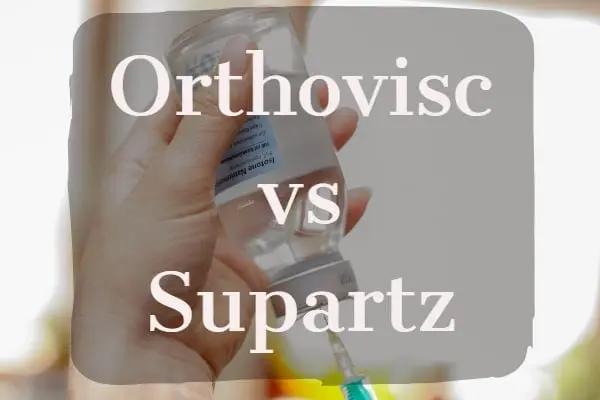
Viscosupplements are medication that are administered to provide cushioning and lubrication to the affected knee joint. Usually given after the standard therapies have failed to produce adequate relief of arthritic symptoms, these intraarticular injections have been shown to be safe treatments that can assist in the management of this often painful, debilitating disease. This article will take a closer look at two viscosupplements, Supartz injectables and Orthovisc treatments, and see how they compare to each other.
How do Orthovisc and Supartz help patients with knee osteoarthritis?
In healthy individuals, joint spaces are filled with synovial fluid, a viscous fluid with an egg white-like consistency. Synovial fluid reduces friction between adjacent cartilage tissues during joint movement; thus, minimizing damage from wear and tear. However, aging impacts the rheological properties of synovial fluid, reducing in elasticity, viscosity, and rigidity as the patient grows older. In some cases, these changes also reduce the capability of the fluid to absorb friction, meaning that the joint now has insufficient lubrication. When this occurs, the resultant wear and tear breaks down the cartilage, leading to direct contact between bone surfaces, and the development of osteoarthritis.
Products like Orthovisc and Supartz are formulated to mimic the physical properties of healthy human synovial fluid. Hence, when it is injected into the knee, these hyaluronic acid products replenish or supplement lubrication to the joint. Thus, the progression of the disease is delayed, and symptoms of pain and inflammation are alleviated.
The results of clinical trials have shown that viscosupplements are effective in managing the symptoms of knee osteoarthritis, with most of the studies mainly reporting a efficacy of around 20% when compared to a placebo. In general, 60–70% of patients receiving this therapy respond to treatment, with delayed but long lasting effects of at least six months. Repeat treatments are usually necessary, but single-dose regiments are available.
Orthovisc vs Supartz – How do they differ?
Treatment regimen
Supartz is approved for weekly five knee injections, but some patients will begin to respond to as few as three injections. In contrast, Orthovisc takes three to four injections, administered weekly, before gaining any therapeutic effect.
Concentration of active ingredient
Orthovisc delivers a higher concentration of hyaluronic acid (15mg/ml) compared to Supartz (10mg/ml), or to most of its other competitors. The high concentration of hyaluronic acid in Orthovisc is a factor in the effectiveness of the product.
Composition
The hyaluronic acid in Orthovisc is derived from bacterial cells, while the hyaluronic acid used to make Supartz is of avian origin. This must be taken into account when considering treatment for a patient with sensitivities to the associated hyaluronic acid sources. Patients with allergies to avian feathers, proteins, or egg products should be dissuaded from using Supartz, while patients who are hypersensitive to Gram positive bacterial proteins should not receive Orthovisc injections.
Adverse event profile
There is some evidence to suggest that products with hyaluronic acid derived from non-avian sources have a lower adverse event profile when compared to products with avian hyaluronic acid.
Conclusion
The viscosupplements Orthovisc and Supartz, while having similarities in therapeutic indications, efficacy rates and active ingredient, have considerable differences in dosing, manufacturing processes, contraindications and adverse event profiles. It is important to take all these differences into consideration when choosing the right product for the patient, in order to provide the best treatment outcomes possible.
Aesthetic injectable companies refer to businesses or companies that specialize in manufacturing, distributing, or providing aesthetic injectable products and services. These companies focus on developing and supplying injectable substances used for cosmetic purposes, typically administered by qualified medical professionals. Aesthetic injectable companies play a crucial role in the field of aesthetic medicine and cosmetic dermatology by offering a variety of injectable products designed to enhance facial features, reduce wrinkles, and improve overall skin appearance.
Key aspects of aesthetic injectable companies include:
-
Product Development: These companies research, develop, and manufacture aesthetic injectables such as dermal fillers, botulinum toxins (e.g., Botox), collagen stimulators, and other specialized formulations. They often innovate new products to meet evolving market demands and technological advancements.
-
Distribution and Sales: Aesthetic injectable companies distribute their products through authorized channels, including healthcare providers, medical spas, and aesthetic clinics. They may also sell directly to licensed professionals who administer these treatments.
-
Regulatory Compliance: Due to the medical nature of their products, aesthetic injectable companies adhere to strict regulatory guidelines and obtain necessary approvals from health authorities (e.g., FDA in the United States) to ensure safety, efficacy, and quality standards.
-
Training and Support: Many companies provide training and educational support to healthcare professionals on the proper use, administration techniques, and safety protocols associated with their injectable products. This ensures that practitioners can deliver treatments effectively and safely.
-
Customer Support: Aesthetic injectable companies offer customer support services to healthcare providers and consumers, addressing inquiries, providing product information, and assisting with product usage and troubleshooting.






